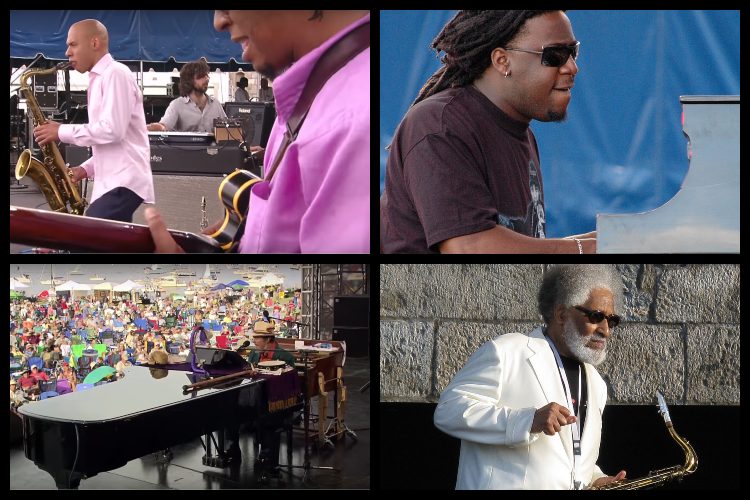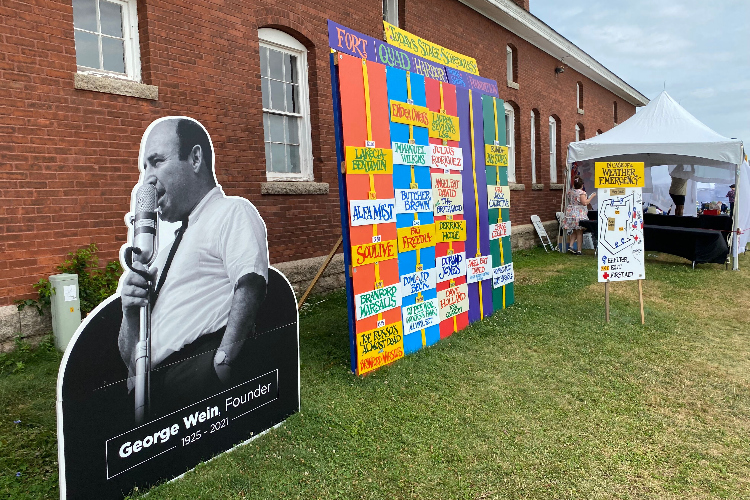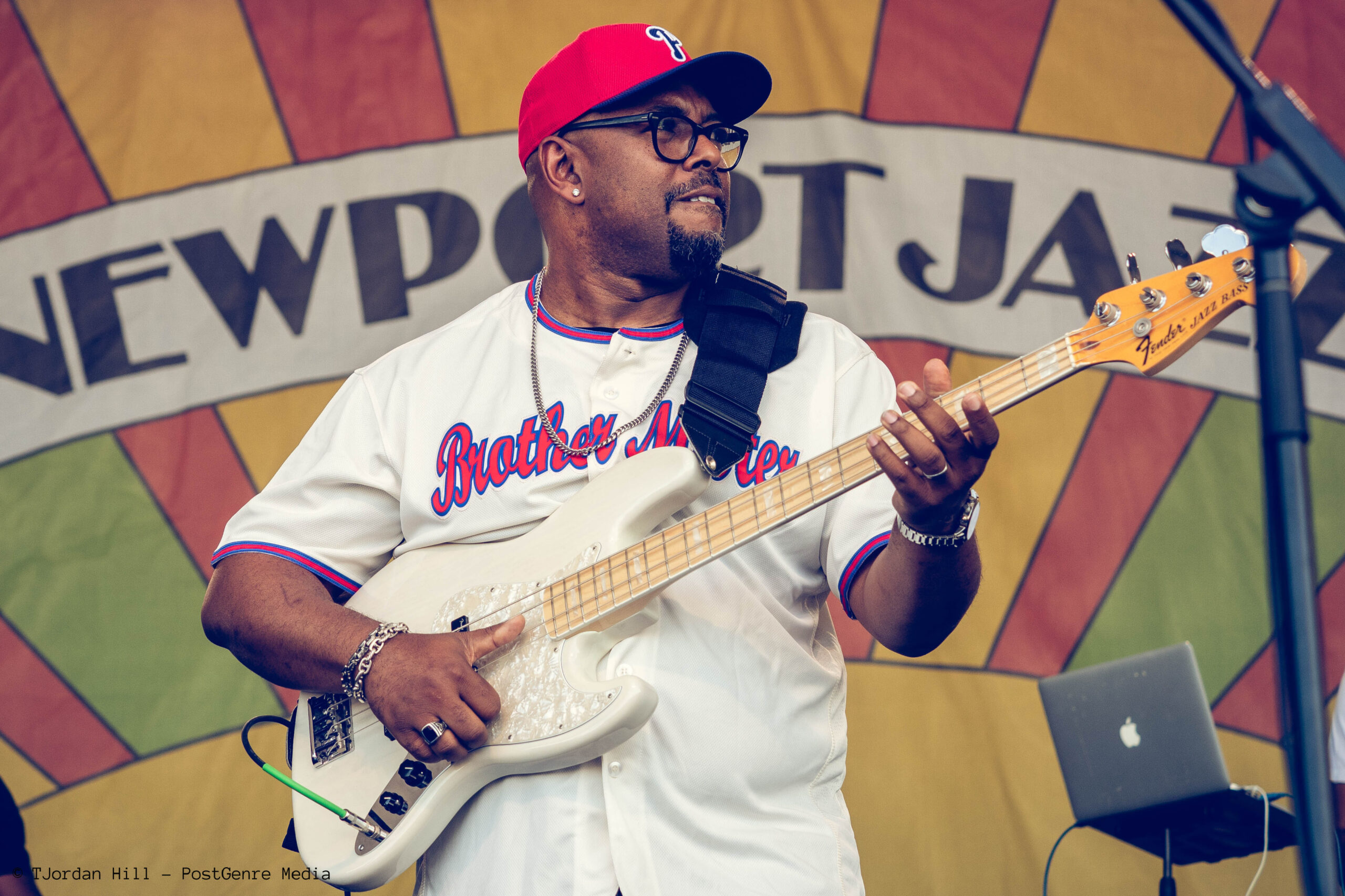A History of the Newport Jazz Festival – Chapter XIV: Destinations, 2005-2009
|
Getting your Trinity Audio player ready...
|
With the success of the 50th Anniversary event, Festival Productions Inc. quickly began work on the 2005 Festival. Like the immediately preceding year, George Wein would be unable to attend the Fort’s proceedings. This time it was not due to his own health but that of his wife’s. Joyce Wein was a brilliant woman. Originally trained as a biochemist, she became a central part of the Festival production team, serving every role from the organization’s Vice President to a hostess for visitors. She played an immense role in the Festival. Joyce died August 15, 2005, a day after that summer’s Jazz Festival.
Like the preceding year, the 51st Newport Jazz Festival began with Thursday festivities away from the Fort. This time, with the special showing of a film at the Jane Pickens Theater. First built as the Zion Episcopal Church in 1834, the building became a live theater in 1918 and began showing silent films in 1922. The Jane Pickens Theater is one of the few places where audiences have watched movies consistently for almost a century. On this occasion, they saw “Miles Electric: A Different Kind of Blue.” Capturing the trumpeter at the 1970 Isle of Wight Festival, the film’s inclusion as part of the Jazz Festival was a subtle nod to both the concert that half a century early made his career as well as a respect for his constant changes in style and artistic output.
If the piano was the focal point of the 2004 Festival, for 2005, it was the guitar. The small side stage became dedicated as a center for six strings. Mark Whitfield appeared with his trio featuring Donald Edwards and Reuben Rogers. Russell Malone- who was part of Ron Carter’s trio the previous summer- performed with Benny Green. Larry Coryell visited Newport for the first time since he was part of Gary Burton’s group at the 1967 Festival. Burton protegee Julian Lage duetted with pianist Taylor Eigsti. Kurt Rosenwinkel and Bill Frisell both made their Newport debuts. The Newport All-Stars included the skills of Howard Alden.
Even Joshua Redman’s Elastic Band built itself to some degree around the fingerwork of Jeff Parker. While the saxophonist had presented several projects at the Festival by 2005, this group was different. In utilizing Fender Rhodes, electric guitar, and distorted horn run through various pedals, the project merged 70s fusion with more contemporary acid jazz and hip hop. The leader’s ebullient tone bounced and echoed off of the Fort’s walls and into the audience.
The guitar celebration even seeped into another of the weekend’s highlights, an 80th Birthday celebration of Roy Haynes, with a surprise appearance by Pat Metheny. Principally built off of Haynes’ Fountain of Youth band, various announced guests – including Redman, Chick Corea, Christian McBride, Gary Burton, and Wynton Marsalis – joined the group throughout. The multitude of visitors was both a celebration of the drummer’s legacy and a harkening back to some of Newport’s infamous jam sessions of summer’s past. The excitement of the performances was inescapable; at one point between sets, an enthusiastic audience even sang “Happy Birthday” to Haynes.
Besides the guest of honor, there were several other longstanding artists. The weekend opened with Eartha Kitt and the Artie Shaw Orchestra (though the bandleader passed the preceding December) at the Tennis Hall of Fame. At the Fort, Carla Bley performed at the Festival with her Lost Chords group, the first time she had been at Newport since the afternoon in 1965 celebrating jazz’s “new thing.” Dave Brubeck’s Quartet reappeared, this time joined by Wynton Marsalis. In another cross-generational meeting, Hank Jones’ Trio was augmented by Joe Lovano in a soulful set that would, over a decade later, became “Classic! Live at Newport.”
Lovano would perform as part of a Saxophone Summit with Dave Liebman. The set was perhaps most notable, however, for its absent third horn player. Michael Brecker, who had developed a significant following, was by now struggling with myelodysplastic syndrome. He was also originally scheduled with the group Steps Ahead, though Bill Evans filled in for him. Missing Brecker’s presence, nearly 300 festival attendees agreed to bone-marrow screenings in hopes of finding a match for the saxophonist or others. Despite such efforts, the illness would ultimately lead to Leukemia and Brecker’s death.
Other performances include tributes to Cannonball Adderley and Dizzy Gillespie, a trio of Stanley Clarke, Bela Fleck and Jean Luc-Ponty, Medeski Martin & Wood returned to promote End of the World Party (Just in Case) (Blue Note, 2004).
Dave Holland presented his Big Band featuring Robin Eubanks, Chris Potter, Antonio Hart, Gary Smulyan, and Nate Smith.
Charles Lloyd, Don Byron, drummer Matt Wilson, and vocalist Patricia Barber made their Newport debuts.
Barber was the only vocalist showcased at the Fort at the 2005 Jazz Festival. To try to make up for the lack of representation, the 2006 Festival included several singers beginning with John Pizzarelli and Jane Monheit on Friday evening. The rest of the weekend brought Luciana Souza, Raul Midon, Andy Bey, and Angelique Kidjo.
Across the weekend, Al Jarreau gave glimpses into his forthcoming duet album with George Benson, Givin’ It Up (Concord, 2006), which would ultimately be nominated for several Grammys. The guitarist joined Jarreau for his first song while Benson shared three with the vocalist, including a finale of “On Broadway” with assistance from Arturo Sandoval.
In line with Jarreau and Benson, Chris Botti emphasized some listeners’ remaining love for “smooth jazz.”
The 2006 Festival also honored the great musical heritage of New Orleans. A year after Hurricane Katrina devastated the metropolis, some of its finest artists showed the continued vitality of the great city’s musical scene. The Preservation Hall Jazz Band shared the traditional sounds which made jazz such a powerhouse musical form. McCoy Tyner’s All-Stars featured saxophonist and educator Donald Harrison. Reflecting the youngest generation in the musical family tree was Christian Scott (then known without the aTunde Adjuah appellation) with his Quartet. And, in between, Dr. John’s unique blurring of jazz, blues, funk, and rock.
Other highlights of the weekend included the Newport debuts of Cyrus Chestnut, Marc Ribot, Hiromi, trumpeter Avishai Cohen, and Robert Glasper.
With Gold Sounds, Chestnut, James Carter, Ali Jackson, and Reginald Veal bridged the gap between jazz quartet and the indie rock band, Pavement. Savion Glover emphasized the connection between the use of rhythm in dancing and that in music.
Long-standing favorite Dave Brubeck returned. As did George Wein who, to celebrate his first Festival in two years, performed with The Newport All-Stars.
However, the founder was not the young man he once was over a half-century earlier. Now in his early 80s, he increasingly considered the legacy of his work and its future. Perhaps these thoughts were even more prominent in light of the passing of his friends and colleagues, including his wife Joyce, over the years. With this background in mind, when approached with an opportunity to sell Festival Productions Inc., he agreed to the opportunity.
In January of 2007, George Wein agreed to sell his rights to the Festival to a start-up company, Festival Network. The acquirer’s focus was wholly on “destination festivals”; promoting concerts to drive tourism revenue to less populated places. While this model worked well in a place like Newport that is only a few hours away from major cities, it was a harder sell for other planned locations like Jackson Hole, Wyoming. Under the agreement, Wein would keep the title producer-emeritus while Festival Network would obtain the rights to use the Newport Jazz and Newport Folk names and present and manage them as their own.
The Festival Network spent heavily, always looking for ways to grow through increased expenditures. For instance, the tradition of having members of the jazz press, radio, and others introduce artists was replaced by selecting a celebrity – comedian Chevy Chase, a surprisingly adept pianist – as an official master of ceremonies.
Perhaps to show the change in leadership had not divorced the event from its historical roots, the 2007 Festival heavily emphasized tribute performances. The Dizzy Gillespie All-Star Big Band and its many special guests – including Slide Hampton, James Moody, Jimmy Heath, and Roy Hargrove – revisited the 1957 Festival. Drummer Ben Riley shared the music of his once bandleader, Thelonious Monk. Other tributes included those to Rahsaan Roland Kirk, Bill Evans, and Stan Getz and Carlos Jobim by Steve Turre, Elaine Elias, and Harry Allen respectively. The Mingus Orchestra examined the music of its namesake but with a Third Stream lens as it was conducted by Gunther Schuller.
At the same time, the newly managed Festival maintained the expansive view of music, refusing to limit its scope to solely jazz. Zap Mama presented her Afro-pop-infused vocals. Soulman Al Green shared “Love and Happiness” with the attentive audience. The multi-genre vocalist Etta James was scheduled to sing as well. Due to ill health, however, she was replaced by guitarist Susan Tedeschi. And blues monarch B.B. King- who had appeared at Newport several times since the 1960s – made one last performance there.
Elsewhere, the lineup included a mixture of both well-established artists and emerging ones. Newport mainstay Dave Brubeck appeared with both his quartet and a group led by his sons. Abdullah Ibrahim issued a solo piano offering in his first time at Newport since 1965’s “Jazz for Moderns.” Marcus Miller blurred jazz, R&B, and funk in his first appearance at the Festival as a leader. Paquito D’Rivera shared music with a Latin tinge with his Panamericana Ensemble featuring harp wizard Edmar Castañeda. Young bassist Esperanza Spalding was showcased in Donald Harrison’s Quintet. Anat Cohen reminded audiences of the clarinet’s long history in jazz music. Other sets included Branford Marsalis, Joshua Redman’s Trio, Chico Hamilton, Kenny Werner, Roswell Rudd, Luciana Souza, Ron Carter, Jon Faddis, and bassist Ben Allison. Bruce Hornsby stepped away from his pop influences to focus on a more traditional trio with Jack Dejohnette and Christian McBride.
But the end of 2007 also meant significant economic troubles. Throughout 2008, a hyperinflated housing market’s bubble burst, causing economic chaos. Many saw the “Great Recession” as the worst economic calamity since the 1930s as household net worth fell $11.5 Trillion. Nevertheless, the 2008 Festival continued unabated with a heavy emphasis on both funk – the groups Lettuce and Soulive both collaborated with once James Brown trombonist Fred Wesley – and R&B- shown by singers Ledisi and Anthony Hamilton. The Queen of Soul, Aretha Franklin, moved Newport audiences one last time.
The Festival Network also offered an opportunity for lesser-known artists to appear at their esteemed event by pairing with OurStage, a platform focused on finding new talent. After an extensive search, two groups were selected to perform. One, Ameranouche, is a trio inspired by the sounds of artists like Django Reinhardt to create something new called “gypsy flamenco.” The other was Dred Scott’s Trio, an ensemble that tries to place a humorous spin on bop.
Another experiment was the Festival’s “Sunday Surprise” on the Waterside stage, the small space formerly focused on a specific instrument. With a desire to provide a large name artist – Bill Frisell’s trio – in a more intimate venue, the set remained a secret until the artist took the stage. While an interesting experiment in concept, the space quickly became overrun with crowds as the guitarist’s ethereal tones were heard. Frisell also appeared that weekend as part of a fascinating trio with Charlie Haden and Ethan Iverson.
The Waterside stage also provided a venue to host the return of Christian Scott. His band – with Walter Smith III, Matthew Stevens, Aaron Parks, Joe Sanders, and Jamire Williams – shared early insight into the sensitive and thoughtful direction in which the trumpeter would stretch music. The result is captured on Scott’s first live album, Live at Newport (Concord, 2008).
Chris Potter was perhaps the busiest person that weekend. He explored the intersection of jazz and rock with his Underground group featuring Adam Rogers, Craig Taborn, and Nate Smith as well as with Marco Benevento’s in his reimagining of songs by Led Zeppelin, Deerhoof, and My Morning Jacket. That weekend the saxophonist also performed in separate sets with Dave Holland and Herbie Hancock, the latter including an extensive fifteen-minute version of “Chameleon.”
Hancock’s former bandmate, sometimes collaborator, and longtime friend, Wayne Shorter presented his quartet that weekend as well. Mark Rapp’s band provided a rousing version of the Meters’ “Cissy Strut” and showed how, in the right hands, even a didgeridoo could be a powerful improvisatory tool. Brain Haas’ Jacob Fred Jazz Odyssey merged jazz and electronica on the songs of Lil’ Tae Rides Again (Hyena, 2008). Other artists included Chris Botti, Melody Gardot, Warren Vache, Aaron Goldberg, Lionel Loueke, Guillermo Klein y Los Gauchos, George Wein’s Newport All-Stars, Esperanza Spalding, and UK-based band Empirical.
The weekend concluded with the legendary Saxophone Colossus, Sonny Rollins. In his first time at Newport since a duet with Coleman Hawkins at Freebody Park, Newk confirmed the vibrant power of his lengthy calypso-infused improvisations had not waned in the ensuing decades.
But as economic conditions worsened, the Newport Jazz Festival’s future became increasingly precarious. The event’s new owner, The Festival Network, found itself in financial distress with its “destination festival” concept a failure, particularly at a time when people were increasingly monitoring their spending. Equally troubling, JVC – following a recent merger with the Kenwood Corporation – indicated that after twenty-four years it would no longer support jazz festivals. Only four years earlier, the Newport Jazz Festival ended with a massive celebration of its golden anniversary. Now, it was uncertain whether the event could survive at all.
The 2021 Edition of the Newport Jazz Festival will take place from July 30th to August 1st at Fort Adams State Park. We plan to have live coverage of the event. More information can be found on the Festival’s website.




One thought on “A History of the Newport Jazz Festival – Chapter XIV: Destinations, 2005-2009”